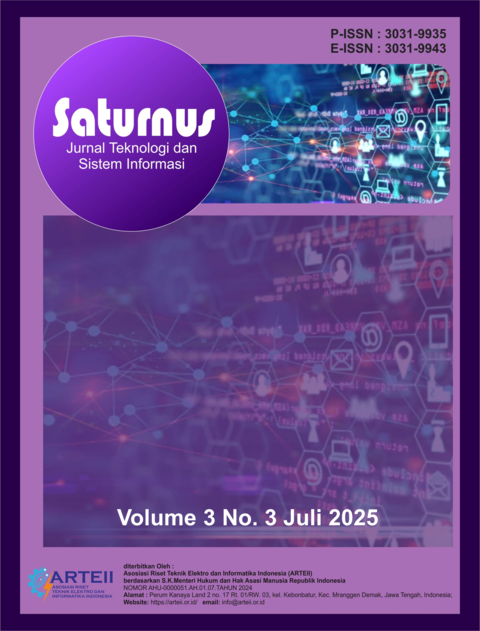Faktor Penerimaan Teknologi Shopee di Kalangan Mahasiswa: Integrasi Model TAM dan TPB
DOI:
https://doi.org/10.61132/saturnus.v3i3.856Keywords:
e-commerce, SEM, Shopee, students, TAM, technology acceptance, TPBAbstract
This study aims to analyze the factors that influence the acceptance of Shopee e-commerce technology among students with an integrative approach between the Technology Acceptance Model (TAM) and the Theory of Planned Behavior (TPB). External constructs such as perceived trust, perceived security, and innovativeness are also included to strengthen the model. This study uses a quantitative approach with a descriptive-verification design and Structural Equation Modeling (SEM) analysis technique. Data were collected through an online questionnaire answered by 135 active Shopee student users. The results of the analysis show that perceived ease of use has a significant effect on perceived usefulness and attitude toward usage, while perceived usefulness also has a significant effect on attitude and intention to use. Social factors such as subjective norms, as well as psychological factors such as trust and security have been shown to have a positive effect on usage intention. However, perceived behavioral control does not have a significant effect. This study provides a theoretical contribution to the modeling of digital technology adoption and has practical implications for e-commerce industry players in developing strategies based on student users.
References
Ruiz-Herrera, L. G., Montoya-Blandón, S., Giraldo-O'Meara, M., Montoya-Alzate, J. L., & Castaño-Peña, J. M. (2023). Technology acceptance factors of e-commerce among young people: An integration of the technology acceptance model and theory of planned behavior. Heliyon, 9, e16418. https://doi.org/10.1016/j.heliyon.2023.e16418
Ajzen, I. (1991). The theory of planned behavior. Organizational Behavior and Human Decision Processes, 50(2), 179–211. https://doi.org/10.1016/0749-5978(91)90020-T
Davis, F. D. (1989). Perceived usefulness, perceived ease of use, and user acceptance of information technology. MIS Quarterly, 13(3), 319–340. https://doi.org/10.2307/249008
Grabner-Kräuter, S., & Breitenecker, R. J. (2011). Trust in online environments: A media psychology perspective. Journal of Media Psychology, 23(3), 114–123. https://doi.org/10.1027/1864-1105/a000044
Gurung, A., & Raja, M. K. (2016). Online privacy and security concerns of consumers. In Encyclopedia of E-Commerce Development, Implementation, and Management (pp. 1430–1445). IGI Global. https://doi.org/10.4018/978-1-4666-9787-4.ch103
Hair, J. F., Black, W. C., Babin, B. J., & Anderson, R. E. (2010). Multivariate data analysis (7th ed.). Pearson Education.
Ketabi, S., Ranjbarian, B., & Ansari, A. (2014). Analysis of the effective factors on online purchase intention through theory of planned behavior. International Journal of Academic Research in Business and Social Sciences, 4(4), 374–382. https://doi.org/10.6007/IJARBSS/v4-i4/819
Rogers, E. M. (2003). Diffusion of innovations (5th ed.). Free Press.
Taylor, S., & Todd, P. A. (1995). Understanding information technology usage: A test of competing models. Information Systems Research, 6(2), 144–176. https://doi.org/10.1287/isre.6.2.144
Wang, Y. D., & Emurian, H. H. (2005). An overview of online trust: Concepts, elements, and implications. Computers in Human Behavior, 21(1), 105–125. https://doi.org/10.1016/j.chb.2003.11.008
Populix. (2023). Shopee, e-Commerce yang Paling Diandalkan Gen Z dan Milenial Indonesia. Databoks. Retrieved from https://databoks.katadata.co.id/teknologi-telekomunikasi/statistik/887c3d33f84f194/shopee-e-commerce-yang-paling-diandalkan-gen-z-dan-milenial-indonesia
Nurhasanah, E. (2023). Analisis Penggunaan E-Commerce Shopee terhadap Perilaku Konsumtif Mahasiswa. Pekobis: Jurnal Pendidikan, Ekonomi, dan Bisnis, 8(1), 48–59. Retrieved from https://openjournal.unpam.ac.id/index.php/Pekobis/article/download/30254/pdf
Ruiz-Herrera, L. G., Valencia-Arias, A., Gallegos, A., Benjumea-Arias, M., & Flores-Siapo, E. (2023). Technology acceptance factors of e-commerce among young people: An integration of the technology acceptance model and theory of planned behavior. Heliyon, 9, e16418. https://doi.org/10.1016/j.heliyon.2023.e16418
Alalwan, A. A. (2020). Mobile commerce adoption in developing countries: A review and research agenda. International Journal of Information Management, 53, 102104. https://doi.org/10.1016/j.ijinfomgt.2019.102104
Venkatesh, V., Morris, M. G., Davis, G. B., & Davis, F. D. (2003). User acceptance of information technology: Toward a unified view. MIS Quarterly, 27(3), 425–478. Link stable
Alalwan, A. A., Dwivedi, Y. K., & Rana, N. P. (2017). Factors influencing adoption of mobile banking by Jordanian bank customers: Extending UTAUT2 with trust. International Journal of Information Management, 37(3), 99-110. https://doi.org/10.1016/j.ijinfomgt.2017.01.002
Downloads
Published
How to Cite
Issue
Section
License
Copyright (c) 2025 Saturnus : Jurnal Teknologi dan Sistem Informasi

This work is licensed under a Creative Commons Attribution-ShareAlike 4.0 International License.





